Curated Guides > Syllabus > Early Modern Art Syllabus (c. 1400–1800)
Early Modern Art Syllabus (c. 1400–1800)
This course introduces global art histories in the Early Modern era. Students engage critically with the impact of trade, religion, and colonization on art, identity, politics, and societal values with focus on perspectives from Eurasia, Africa, the Americas, and the Pacific Islands.
What is art history? Why do we study the art of the past? This unit asks these fundamental questions and introduces ideas about religion and art and what maps can tell us. It also looks at the tools art historians use to look closely.
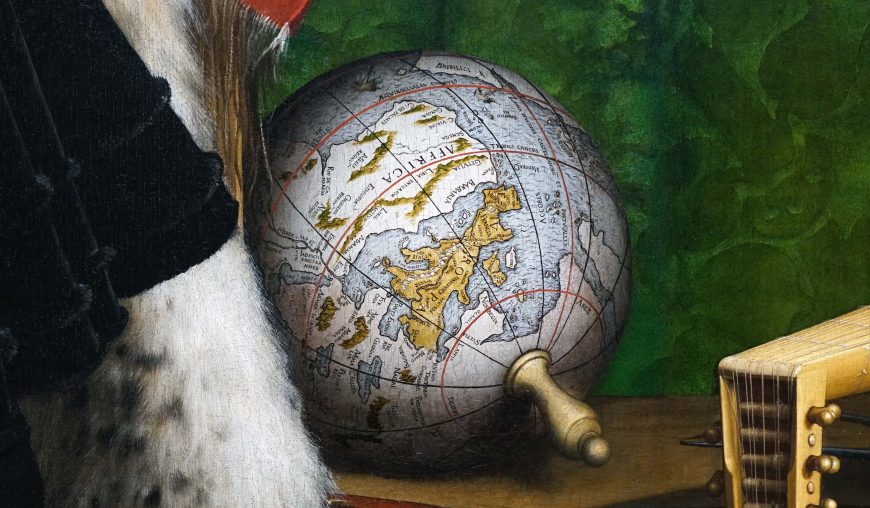
Globe (detail), Hans Holbein the Younger, The Ambassadors, 1533, oil on oak, 207 x 209.5 cm (The National Gallery, London, photo: Steven Zucker, CC BY-NC-SA 4.0)
- About art history
- Ever wondered… why people become art historians?
- Ever wondered…why study art of the past?
- Religion and art
- The five major world religions
- A brief history of religion in art
- Mapping the world
- What maps tell us
- The Catalan Atlas
- Looking closely
- How to do visual (formal) analysis
- On looking closely: Giorgio Morandi, Still Life
- Hinduism, Buddhism, Judaism, Christianity and Islam
- aniconic
- anthropomorphic
- Crown of Aragon
- mappaemundi
- Mansa Musa
- visual analysis
- linear perspective
- orthogonals
- vanishing point
- composition
- foreground
- background
- What are the five major world religions and their core beliefs?
- What are some of the issues to consider when doing visual analysis?
- What can maps tell us?
- What do aniconism and anthropomorphic refer to in this unit?
Key Terms
Key Questions
Many history and art history courses begin in 15th century Europe because there were significant global changes signaling a break with the previous Medieval era.
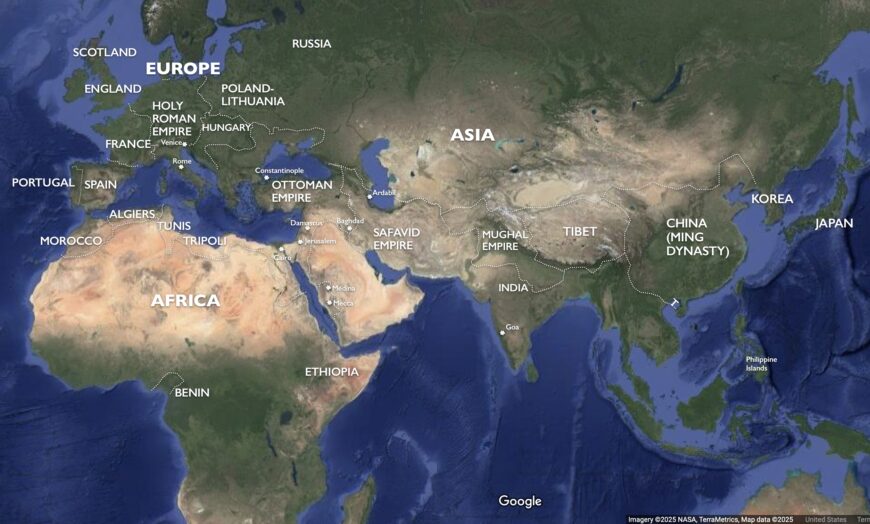
Map of Europe, Africa and Asia c. 1500 (before the Americas were on the international stage) (underlying map © Google)
- Introduction
- The Early Modern era: the 15th century
- Tiny timeline: global Europe
- Types of renaissance patronage
- Female artists in the renaissance
- Italy and Spain
- Filippo Brunelleschi, Pazzi Chapel
- Masaccio, Holy Trinity
- Donatello, Saint George
- A Renaissance Saint James as pilgrim
- Northern Europe
- Workshop of Robert Campin, Annunciation Triptych (Merode Altarpiece)
- Jan van Eyck, Madonna with Canon Joris van der Paele
- Rogier van der Weyden, The Seven Sacraments
- Printmaking in Europe, c. 1400−1800
- Ottoman Empire
- Hagia Sophia as a mosque
- Early Modern period
- humanism
- printing press
- Ottoman Empire
- Christopher Columbus
- Mexica (Aztec)
- Ancient Greece and Rome
- linear perspective, orthogonal, vanishing point
- patron / commission
- Florence
- Bruges
- Istanbul
- colonialism
- Ionic and Corinthian
- Reconquest
- What impact did the printing press have?
- What are some historical factors that contributed to the Renaissance?
- What are some characteristics of Italian and Northern Renaissance art?
- What obstacles did women artists face in the Renaissance?
- How was the Reconquest important for the Spanish colonization of the Americas?
Key Terms
Key Questions
This unit looks at centers of power in the Americas, Asia, and Africa.

Map of North America and South America (underlying map © Google)
- Americas
- Introduction to the Aztecs (Mexica)
- Coatlicue
- Introduction to the Inka
- Asia
- Canteen
- A Ritual Ming dish
- Art Appreciation: Spotlight—Sesshu Toyo’s Winter Landscape
- Ryōanji (Peaceful Dragon Temple)
- Africa
- Kilwa Kisiwani, Tanzania
- Kilwa pot sherds
- African art and the effects of European contact and colonization
- Mexica (Aztec)
- Templo Mayor
- Tenochtitlan
- Coatlicue
- Inka
- Hernan Cortés
- Spanish conquest
- Andes
- Francisco Pizarro
- quipu
- Ming Dynasty
- Zen Buddhism
- symmetrical
- Kilwa Kisiwani
- Swahili
- Why was Chinese porcelain so prized?
- How do we see the ideas of Zen Buddhism in Japanese painting and gardens?
- Why was Kilwa important?
- What are some of the characteristics of the art and culture of the Mexica?
- What are some of the characteristics of the art and culture of the Inka?
Key Terms
Key Questions
This unit looks at the Protestant Reformation, the Counter-Reformation, and the role art played during this tumultuous period.
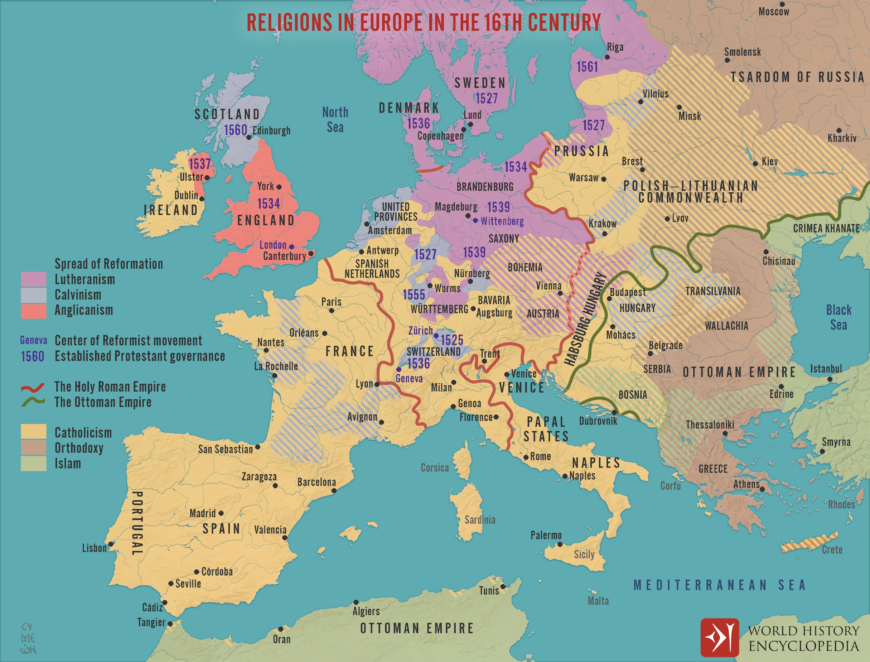
Religions in Europe in the 16th century
- Introduction
- The Early Modern era: the 16th century (2 of 4)
- Reformation and Counter-Reformation
- Introduction to the Protestant Reformation (part 1 of 4): Setting the stage
- Introduction to the Protestant Reformation (part 2 of 4): Martin Luther
- Introduction to the Protestant Reformation (part 3 of 4): Varieties of Protestantism
- Introduction to the Protestant Reformation (part 4 of 4): The Counter-Reformation
- Reforming and destroying
- The Council of Trent and the call to reform art
- Iconoclasm in the Netherlands in the Sixteenth Century
- Bernardo Bitti, Coronation of the Virgin
- Martin Luther
- Reformation
- Counter-Reformation
- Council of Trent
- iconoclasm
- transubstantiation
- Viceroyalty of Peru
- Jesuit
- Catholic
- indulgence
- John Calvin
- Andes / Andean
- Viceroyalty of New Spain
- Viceroyalty of Peru
- What were some of Martin Luther’s objections to the practices and teachings of the Catholic church?
- What were the Protestant concerns about religious art?
- What did the Council of Trent recommend regarding religious art?
- Why do works of art become targets of political and religious intolerance?
Key Terms
Key Questions
This unit looks at the art of the Renaissance in Europe, the architecture of Sinan in the Ottoman Empire, manuscript painting in Safavid Iran and a Chinese hanging scroll.
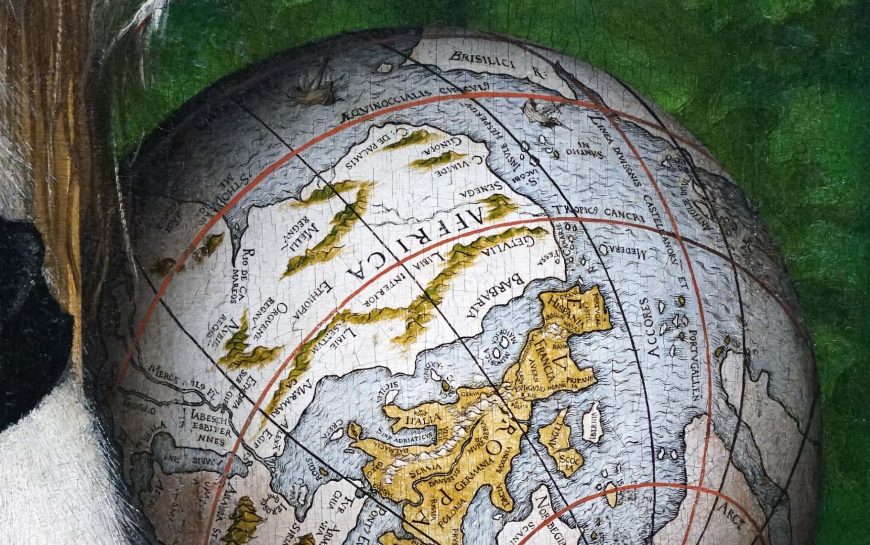
Globe (detail), Hans Holbein the Younger, The Ambassadors, 1533, oil on oak, 207 x 209.5 cm (The National Gallery, London, photo: Steven Zucker, CC BY-NC-SA 4.0)
- Europe
- The Medici collect the Americas
- Michelangelo, Ceiling of the Sistine Chapel
- Leonardo, Last Supper
- Saint Peter’s Basilica
- Dürer’s Rhinoceros: art, science, and the Northern Renaissance
- Follower of Bernard Palissy, rustic platter
- Diego Velázquez, Portrait of Sebastián de Morra
- The carpet and the globe: Holbein’s The Ambassadors reframed
- Asia
- Mimar Sinan, Süleymaniye Mosque, Istanbul
- The Court of Gayumars—part 1
- Wen Zhengming, Wintry Trees
- Pope Julius II
- memento mori
- Ottoman
- Suleiman the Magnificent
- Shah Tahmasp I
- Ignudi
- Plato
- Aristotle
- Shahnameh / Shahnama
- Saint Peter
- dome on pendentives
- muqarnas
- hanging scroll
- Ming Dynasty
- calligraphy
- What are some of the characteristics of the style of the Italian High Renaissance?
- Why did Pope Julius II commission Raphael, Michelangelo, and Bramante to build and paint for him?
- What are some of the qualities of Ottoman mosque architecture that we can see in Mimar Sinan’s Süleymaniye Mosque
- What are some of the qualities of Safavid manuscript painting that we can see in The Court of Kayumars?
- How does Holbien use symbols to enrich his painting, The Ambassadors?
Key Terms
Key Questions
This essay explores colonialism in art in the Americas.
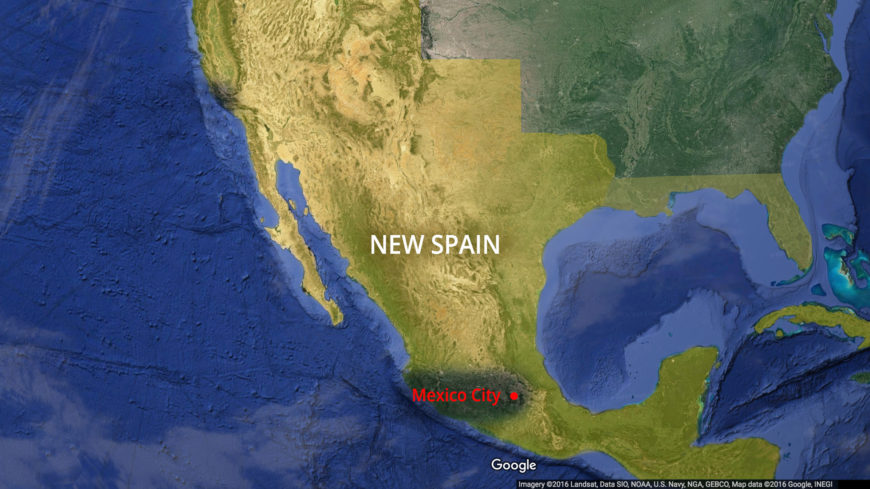
Map of New Spain (underlying © Google)
- Introduction
- Introduction to the Spanish Viceroyalties in the Americas
- North America
- Mission churches as theaters of conversion in New Spain
- Atrial Cross at Acolman
- Bernardino de Sahagún and Indigenous collaborators, Florentine Codex
- Saintly violence? Santiago on Horseback
- South America
- City of Cuzco
- Early Viceregal Architecture and Art in Colombia
- Introduction to colonial Brazil
- Painting Brazil for the Dutch art market, Frans Post, Landscape with Ruins in Olinda
- Albert Eckhout, Series of eight figures
- evangelization
- Mestizo
- mission
- Viceroyalty of New Spain
- convento
- atrium
- Cusco (or Cuzco)
- Afro-Brazilian
- Santiago Matamoros
- estofado
- codex
- featherwork
- manuscript
- Dutch West India Company
- Triangle Trade
- casta painting
- What role did images play in the conversion of Indigenous people to Catholicism?
- What did Saint James represent?
- How do we see the demand for sugar in the art of this period?
- How do we see European art and the art of Indigenous people coming together?
- How did Europeans represent Indigenous people?
Key Terms
Key Questions
This unit investigates the uses of three media, ceramics, textiles, and feathers across a wide geography.

World map (underlying map © Google)
- Porcelain and the forms it inspired
- Medici porcelain, a failed experiment
- Talavera poblana
- Asia in Holland, 17th-century Delftware
- Meissen Porcelain Animals
- Textiles
- Textiles in the Colonial Andes
- Introduction to the court carpets of the Ottoman, Safavid, and Mughal empires
- The Ardabil Carpet
- Ottoman prayer carpet with triple-arch design
- Cashmere shawls
- Featherwork
- Aztec feathered headdress
- A shimmering saint, St. John in featherwork
- Hawaiian featherworks
- porcelain
- Talavera poblana
- Delftware
- Dutch East India Company (V.O.C.)
- Andes
- Ottoman Empire
- Safavid Empire
- Mughal Empire
- Kashmir
- kiln
- kaolin
- stoneware
- earthenware
- hard paste
- Meissen
- What are some examples of the importance of Chinese and Japanese Blue and white porcelain for the European market?
- How are materials and media for making art valued in different cultures?
- How do different cultures come together in the Ottoman Prayer Carpet?
- Why was porcelain so difficult to make?
- Why was porcelain so difficult to obtain?
Key Terms
Key Questions
This unit explores the Baroque style in Italy, Northern Europe, and Ukraine as well as painting and textiles in Asia.
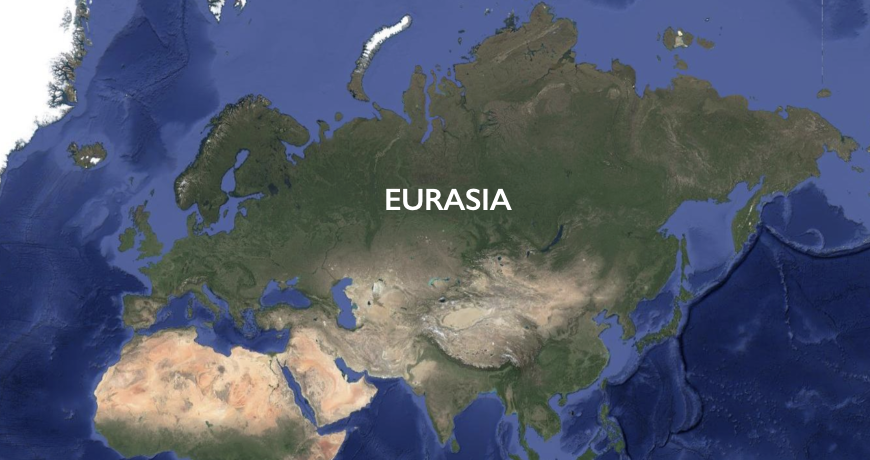
Map of Eurasia (underlying map © Google)
- Introduction
- The Early Modern era: the 17th century
- Introduction to the Global Baroque
- Italy
- Gian Lorenzo Bernini, Cathedra Petri (Chair of Saint Peter)
- Caravaggio, Calling of Saint Matthew
- Artemisia Gentileschi, Judith Slaying Holofernes
- Dutch Republic
- Symbolism and meaning in Dutch still life painting
- The Great Atlas, Dutch edition
- Rembrandt, The Night Watch
- Model of the Dutch East India Company ship “Valkenisse”
- Ukraine
- The Gwoździec synagogue: the lost art of painted wooden synagogues
- Tibet
- The Fifth Dalai Lama Ngawang Lobzang Gyatso (1617–1682) with Previous Incarnations
- India
- The Kevorkian Carpet
- Baroque
- Saint Peter
- Antwerp
- Dutch East and West India Companies (VOC and GWC)
- India Run
- group portrait
- Manilla Gallion
- tenebroso
- Bema
- Torah Ark
- Basilica
- cartography
- Dalai Lama
- Avalokiteshvara
- How does the art of the Protestant Dutch republic differ from the art of Catholic Flanders?
- What was unique about how people bought art in the Dutch Republic?
- What role did the Dutch East India Company play in the growth of the Dutch art market?
- How did the Jews of the Polish-Lithuanian Commonwealth create and decorate a space for worship?
- What was the importance of the Manila Galleon trade?
Key Terms
Key Questions
This unit explores luxury goods and their representation in Europe and Asia and the Americas during the 17th century.
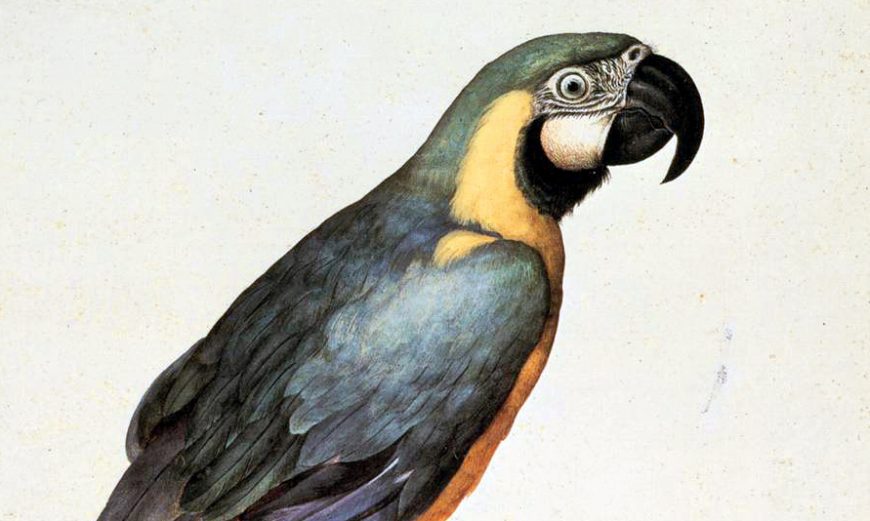
Jacopo Ligozzi, Psittacus Ararauna (Blue and Gold Macaw), c. 1580–1600, 67 x 45.6 cm (Galleria degli Uffizi, Florence)
- Agra (India)
- Shah Jahan’s portrait, emeralds, and the exotic at the Mughal court
- Antwerp (Belgium)
- Osias Beert, Still Life with Various Vessels on a Table
- Copenhagen (Denmark)
- Ole Worm, Museum Wormianum
- Damascus (Syria)
- Bayt Farhi, a Jewish house in Damascus
- Florence and Mantua (Italy)
- Renaissance woman: Isabella d’Este
- Madrid (Spain)
- A Still Life of Global Dimensions: Antonio de Pereda’s Still Life with Ebony Chest
- Mexico City (Mexico)
- Screen with the Siege of Belgrade and Hunting Scene (or Brooklyn Biombo)
- Popayán (Colombia)
- Crown of the Andes
- Versailles (France)
- Louis le Vau, André le Nôtre, and Charles le Brun, Château de Versailles
- biombo
- Medici
- cabinets of curiosities
- codex / codices
- naturalia and artificialia
- maiolica
- Dutch East India Company (V.O.C.)
- still life
- lusterware
- Flemish
- Mughal
- Damascus
- Ottoman
- kwab (or auricular)
- Mughal Empire
- What types of objects were valued and collected?
- What kinds of items would be placed in a cabinet of curiosities?
- Why were still lives an important subject during this period?
- How is the style kwab described?
- How can a cabinet of curiosities be understood as a precursor of the modern museum?
Key Terms
Key Questions
This unit looks at 18th century art across Europe and the Pacific Islands.
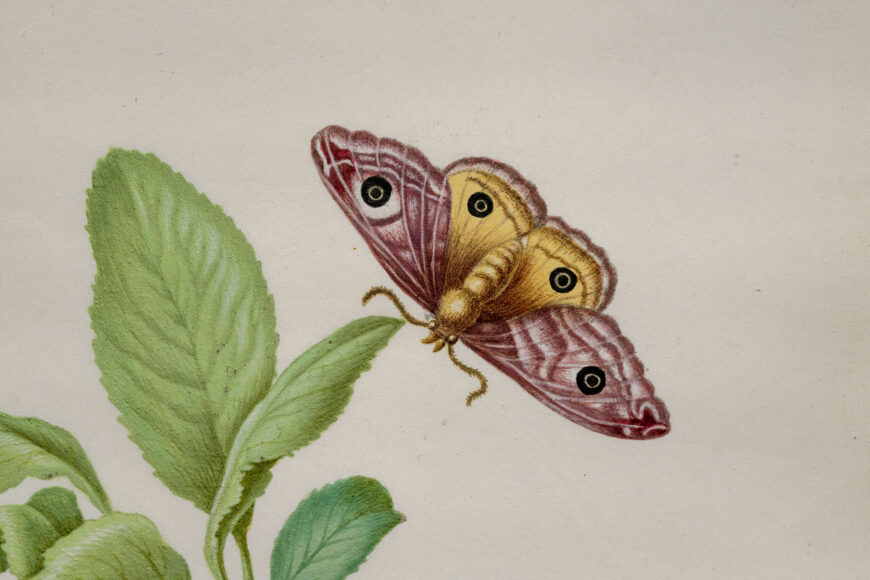
Maria Sibylla Merian, Metamorphosis of a Small Emperor Moth on a Damson Plum, plate 13 of the Caterpillar Book, 1679, translucent and opaque watercolor over counterproof print, on parchment, 18.7 x 14.9 cm (J. Paul Getty Museum, Los Angeles)
- Introduction
- The Early Modern era: the 18th century
- The Age of Enlightenment, an introduction
- Francis Bacon and the Scientific Revolution
- Dutch Republic
- Rachel Ruysch, Fruit and Insects
- France
- Rococo
- A beginner’s guide to Rococo art
- Compound Microscope and Case
Getty Conversations - Jean-Honoré Fragonard, The Swing
- Neoclassicism
- Jacques-Louis David, The Death of Socrates
- Germany / Austria
- Maria Sibylla Merian, Metamorphosis of a Small Emperor Moth
- Joachim Michael Salecker, Cup with cover with Hebrew inscriptions
- Pacific Islands
- Voyage to the moai of Rapa Nui (Easter Island)
- Rurutu figure known as A’a
- Enlightenment
- Reign of Terror
- Francis Bacon
- Rococo
- English gardens
- Louis XV
- Court Jew
- cabinets of curiosities
- Weltallschale
- Scientific Revolution
- compound microscope
- Rapa Nui (Easter Island)
- Moai
- repatriation
- What are some characteristics of the Enlightenment?
- How do we see Enlightenment ideals, rationalism, and first-hand observation in the art of this period?
- Why did Louis XV collect scientific instruments?
- How were Jewish businessmen useful for rulers in Europe? And how did the connections to rulers benefit Jewish communities?
- Why were architectural follies constructed in modern gardens?
Key Terms
Key Questions
This unit looks at the Enlightenment ideal of documenting the Americas, what it meant to be an artist in the American colonies and Asia.
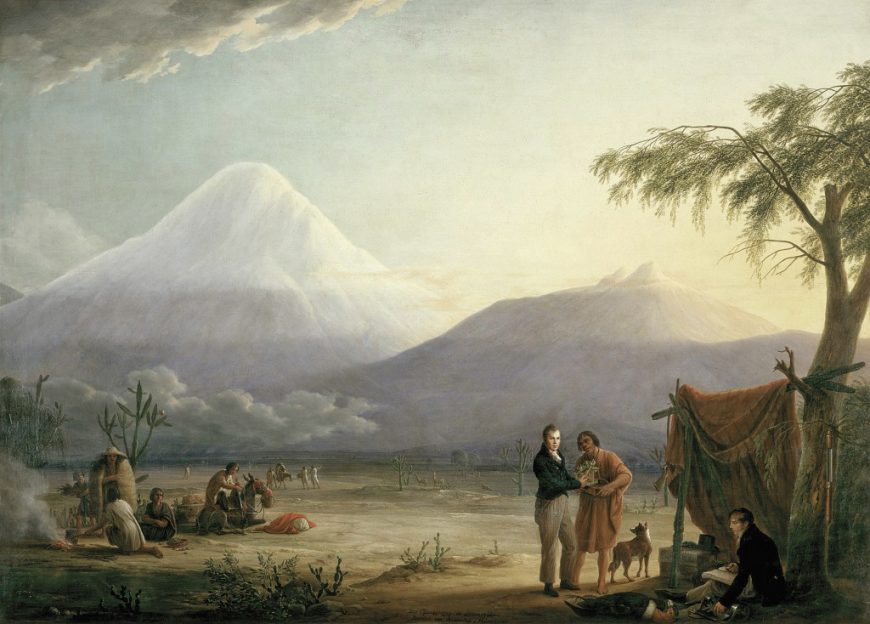
Friedrich Georg Weitsch, Alexander von Humboldt and Aimé Bonpland at the Foot of the Chimboraz, 1806, oil on canvas, 163 x 226 cm (Bildarchiv Preussischer Kulturbesitz)
- Americas
- Benjamin West, The Death of General Wolfe
- John Singleton Copley, A Boy with a Flying Squirrel (Henry Pelham)
- Global trade and an 18th-century Anishinaabe outfit
- Early Scientific Exploration in Latin America
- Francisco Clapera, set of sixteen casta paintings
- Vicente Albán, Quito series
- José Campeche, Portraitist of 18th-century Puerto Rico
- Asia
- Ogata Kōrin, Red and White Plum Blossoms
- Wang Shishen, Garden scene album leaves
- Anishinaabe
- Royal Academy
- history painting
- casta painting
- taxonomy
- cartouche
- Alexander von Humboldt
- San Juan
- Yangzhou
- foreshortening
- Neoclassical
- British Empire
- Qing Dynasty
- hierarchy
- What do we learn about George Washington from Houdon’s sculpture of him?
- What was the effect on artists of the lack of places to receive artistic training in the Americas for most of the 18th century?
- What kinds of concerns do casta paintings reveal?
- Why did Alexander von Humboldt travel to South America?
- What does the word literati refer to?
Key Terms
Key Questions
Few, if any, images survive that were made or commissioned by enslaved people that address their lived experience.
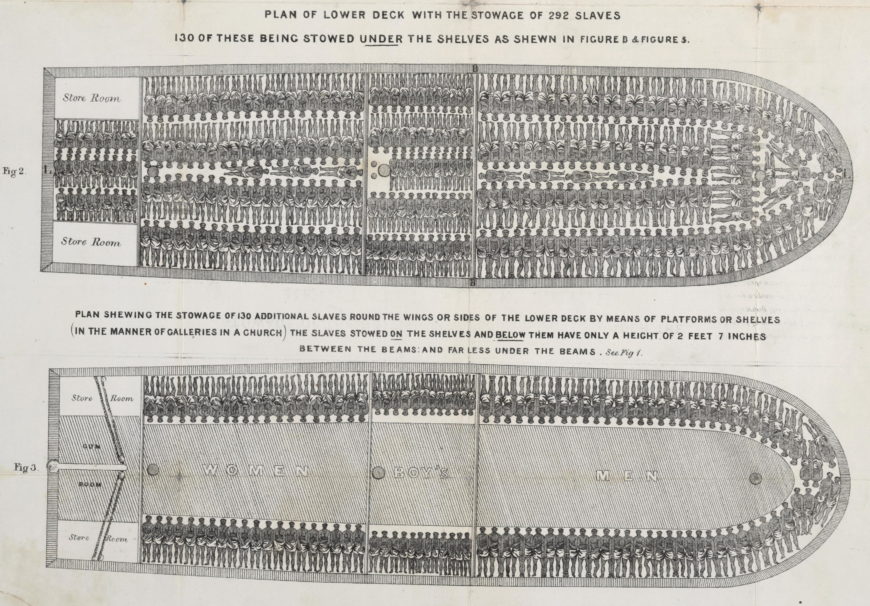
Stowage of the British slave ship Brookes under the regulated slave trade act of 1788, by the Plymouth Chapter of the Society for Effecting the Abolition of the Slave Trade
- The problem of picturing slavery
- Filippino Lippi’s Madonna and Child, an early image of enslaved people in renaissance Florence
- The triangle trade and the colonial table, sugar, tea, and slavery
- A Portrait of Humanity: The Compelling Story of Ayuba Suleiman Diallo
- Diego Velázquez, Juan de Pareja
- Unearthing New York’s history of slavery
- Charles Willson Peale, Yarrow Mamout
- Marie-Guillemine Benoist, Portrait of Madeleine
- Eastman Johnson, A Ride for Liberty — The Fugitive Slaves
- ultramarine / lapis lazuli
- Strozzi family
- The Middle Passage
- manumission
- Eli Whitney
- abolition
- atone
- artifacts
- Pileus cap
- New Christian
- cotton gin
- coffle
- Undergrand Railroad
- self-emancipation
- Fugitive Slave Act
- What did William Wells Brown mean when he wrote “Slavery has never been represented; Slavery never can be represented. . . . “
- How does the African Burial Ground memorialize enslaved people in New York city?
- What are some of the ways that slavery has been depicted in art?
- What was the impact of the invention of the cotton gin?
- How has self-emancipation been depicted in art?
Key Terms
Key Questions
How do contemporary artists come to terms with the legacies of colonialism, slavery, and globalization?
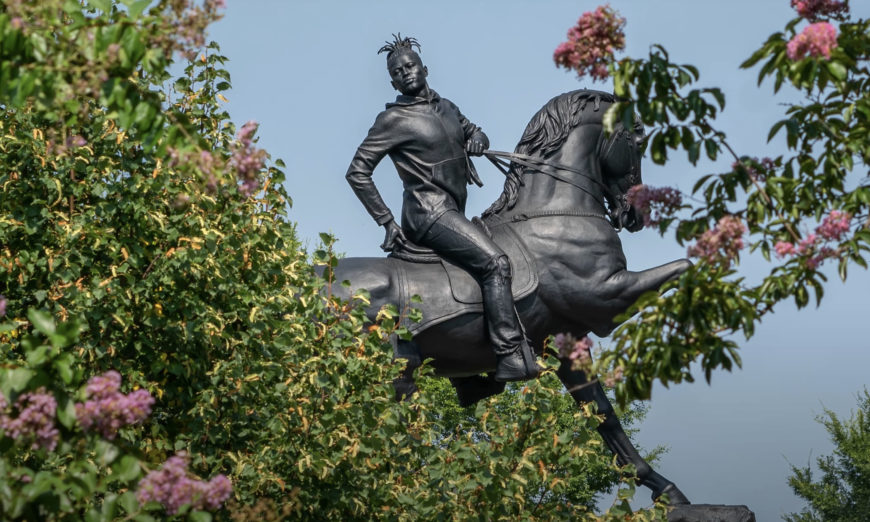
Kehinde Wiley, Rumors of War, 2019, patinated bronze with stone pedestal, 27 feet 4-7/8 inches x 25 feet 5-7/8 inches x 15 feet 9-5/8 inches (Virginia Museum of Fine Arts, Richmond) © Kehinde Wiley
- Kehinde Wiley, Rumors of War
- Wendy Red Star, 1880 Crow Peace Delegation
- Kara Walker, Fons Americanus
- The Black Atlantic: What is the Black Atlantic?
- The Black Atlantic: Identity and Nationhood
- The Black Atlantic: Toppled Monuments and Hidden Histories
- The Black Atlantic: Afterlives of Slavery in Contemporary Art
- Yinka Shonibare, The Swing (After Fragonard)
- What is the impact and legacy of Cook’s voyages?
- What’s in a map? Jaune Quick-to-See Smith’s State Names
- Glenn Ligon, Untitled (America)
- Manifest Destiny
- equestrian
- Black Atlantic
- Confederacy
- Medicine Crow
- James Cook
- Dutch wax fabrics
- batik
- neon
- How do contemporary artists engage with the ideas and legacy of the Early Modern period?
- How does what happened hundreds of years ago with colonialism and slavery impact our lives today?
- In what ways do museums create meaning (in Fred Wilson’s words)?
- Why do you think these artists have decided to reimagine such long ago events?
- What historical events do you find relevant, and how might an artist address it?

 Open All
Open All Collapse All
Collapse All